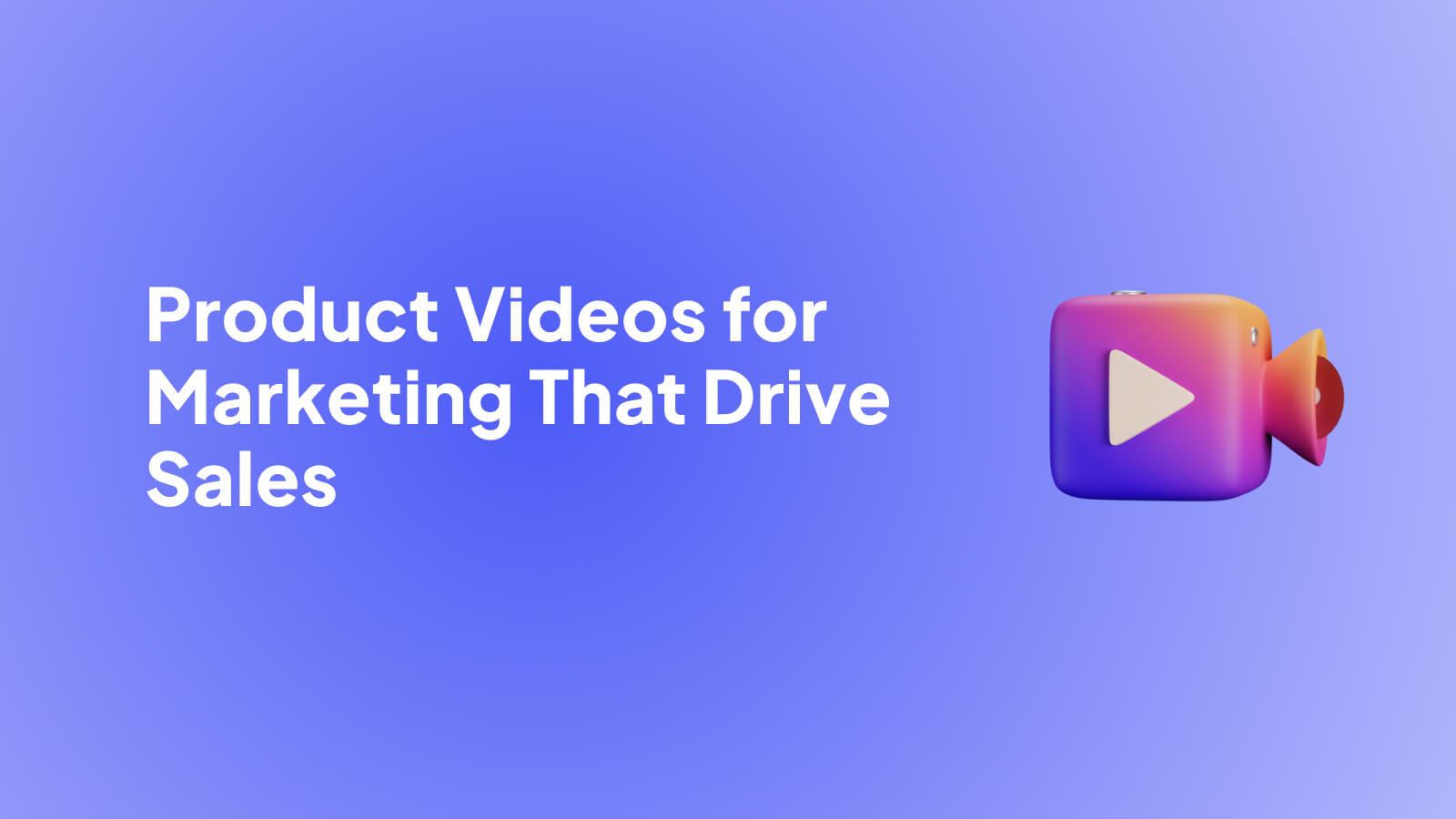
- Why Product Videos Are Your Most Powerful Sales Tool
- Choosing the Right Video for the Right Customer
- Your Framework for Creating Videos That Convert
- Where to Put Your Product Videos So People Actually See Them
- Measuring What Matters for Video Marketing Success
- Frequently Asked Questions About Product Videos
Product videos are more than just moving pictures of your stuff. They're dynamic, engaging assets that show your products in action, helping customers really understand their value. They build trust and give people the confidence they need to make a purchase. Unlike a flat, static image, a great video brings your product to life, bridging the gap between seeing something online and holding it in your hands.
Why Product Videos Are Your Most Powerful Sales Tool
Let’s face it, static images and long blocks of text just don't cut it anymore. In a marketplace overflowing with options, today’s customers expect more. They want to see, feel, and understand a product before they even think about buying it. This is exactly where product videos for marketing come in, turning passive scrolling into an active, engaging experience.
Think of it as putting a virtual version of your product right into your customer's hands. A well-made video does what text simply can't—it shows scale, highlights texture, and demonstrates how something works in just a few seconds. It answers questions the customer might not have even thought to ask and sweeps away doubt by showing, not just telling. This kind of visual storytelling forges an immediate connection and a level of trust that static content can only dream of.
Building Trust Through Transparency
When a customer can see an item from every angle, watch it being used, and grasp its benefits in a real-world setting, their confidence soars. This transparency is absolutely critical for online sales, where people can't physically pick things up. A video acts as a powerful seal of approval for your product's quality and your brand's honesty.
This move toward video isn't some fleeting trend; it’s a deep shift in how businesses connect with their audience. The numbers tell the same story. By 2025, a staggering 89% of businesses worldwide plan to use video marketing as a core part of their strategy. Even more telling, 95% of companies already view video as essential, a huge leap from just a few years ago. It’s clear that businesses everywhere are confident in video's power to hook an audience. You can dive into more video marketing data to see just how big its impact is.
The real job of a product video isn't just to list features. It’s to transfer the confidence you have in your product directly to your customer, making their decision to buy feel both easy and smart.
The Direct Impact on Your Bottom Line
At the end of the day, every marketing move is about growing the business. Product videos are brilliant at this because they directly boost key metrics across the entire marketing funnel. From grabbing attention on social media feeds to sealing the deal on your product pages, video is a versatile workhorse that delivers real, measurable results.
To make this clearer, we've broken down how videos contribute to business goals in the table below.
The Business Impact of Strategic Product Videos
This table summarizes how product videos directly contribute to key business goals and marketing success.
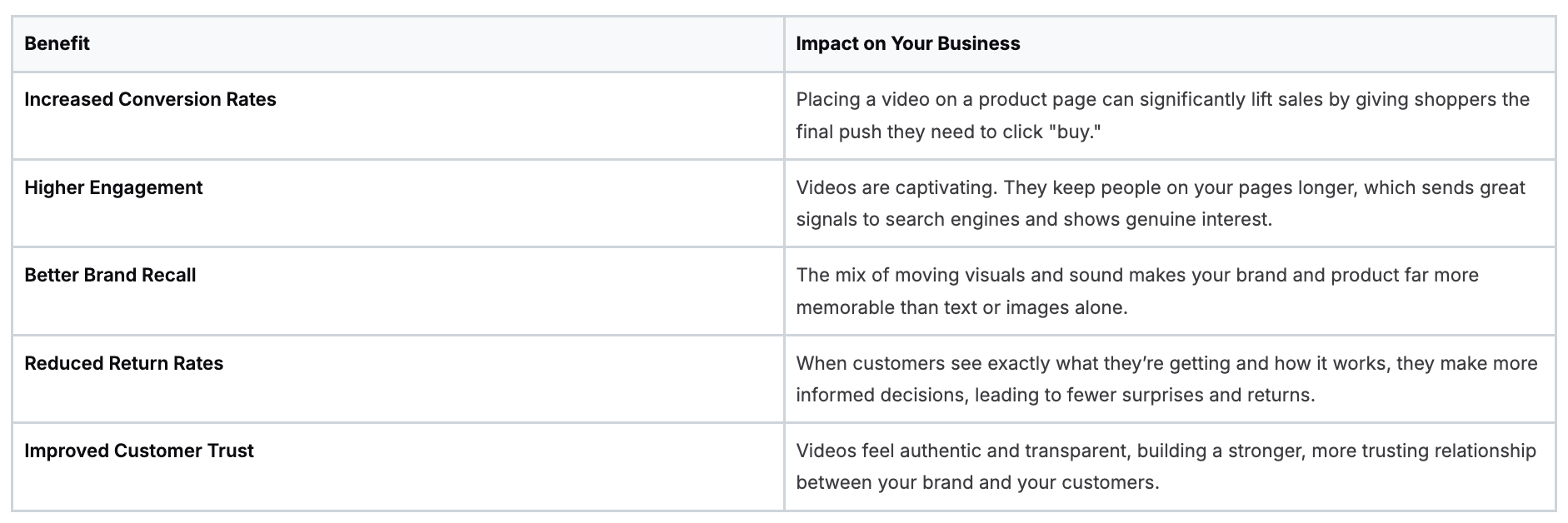
Key Metrics for Measuring Video Marketing ROI
By weaving product videos for marketing into your strategy, you’re not just adding another piece of content. You’re deploying your most persuasive and effective digital salesperson—one that works for you 24/7.
Choosing the Right Video for the Right Customer
Think of your product videos for marketing not as a single blockbuster movie, but as a specialized toolkit. You wouldn't use a sledgehammer to hang a picture frame, right? The same logic applies here. A customer just discovering your brand needs something entirely different from someone who's ready to buy.
The real magic happens when you match the video to the customer's mindset. It’s about meeting them where they are in their journey—from "I've never heard of you" to "I'm ready to check out." Getting this alignment right is how you turn a casual browser into a loyal fan.
Mapping Videos to the Buyer's Journey
Let's break down which videos work best at each stage. This isn't just about making content; it's about strategically guiding potential customers, helping them move forward with confidence.
Awareness Stage: Sparking Interest and Answering "What Is This?"
At the very beginning, your job is to grab attention and introduce a solution to a problem someone might not even know they have. The vibe should be helpful and engaging, not a hard sell.
- Explainer Videos: These are your friendly introductions. They break down a complex product or service into a simple, easy-to-understand concept. The goal is to create that "aha!" moment where everything just clicks for the viewer.
- Promotional Videos: Think of these as the movie trailer for your product. They’re designed to generate buzz and excitement, often highlighting a killer benefit or your unique brand story to stop the scroll on social media.
Consideration Stage: Building Confidence and Answering "Why This One?"
Okay, so they know who you are. Now they’re weighing their options. Your videos at this stage need to build trust and show exactly why your product is the best choice.
- Product Demo Videos: This is where you show, not just tell. A good demo walks viewers through the product in a real-world context, highlighting the features that solve their specific problems. It’s a tangible look at how their life could be better.
- How-To and Tutorial Videos: These are all about providing immediate value. By teaching someone how to accomplish a task using your product, you’re not just selling—you’re proving your product's worth and establishing yourself as an expert.
This visual shows how a product demo, a key asset during the consideration stage, is often consumed on devices like tablets.
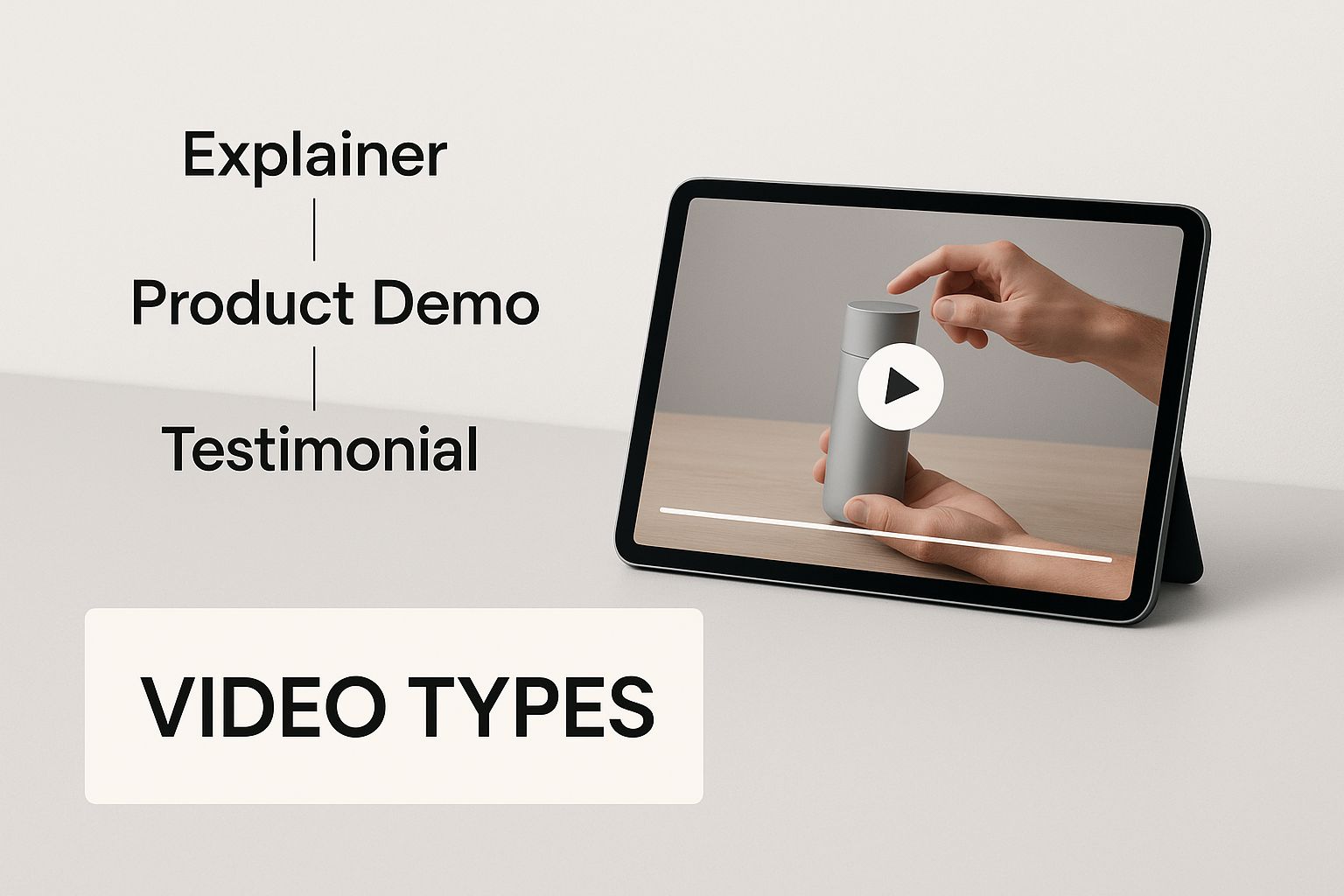
This underscores a key point: when people are seriously researching a purchase, they're often engaging with detailed video content on their personal devices.
Decision Stage: Sealing the Deal and Answering "Am I Making the Right Choice?"
At this final hurdle, the customer needs that last bit of reassurance. They’re looking for proof that they're making a smart decision.
Customer testimonials are the digital equivalent of a trusted friend’s recommendation. They provide powerful social proof by showing real, happy customers, which is often the final nudge a hesitant buyer needs.
- Customer Testimonial Videos: Nothing builds trust like an authentic story from a happy customer. These videos ease last-minute doubts by showing your product delivers on its promises. It’s no surprise that 39% of B2B marketers lean on testimonial videos to get deals across the finish line.
- Feature Announcement Videos: Have you just released an update that solves a common pain point? A quick, focused video announcing that new feature can be the final piece of the puzzle that convinces a buyer to commit.
By strategically using these different types of product videos for marketing, you create a more natural and persuasive path for your customers. You stop guessing and start guiding, offering the right content at the right time. This is how you turn passive views into active conversions.
Your Framework for Creating Videos That Convert
Knowing what kind of video to create is a great start, but the real challenge is turning that idea into a video that actually sells. A lot of people get stuck here, thinking they need a massive budget or years of technical training. The truth is, you don't. A great video is born from smart planning and clear communication, not from expensive equipment.
This guide breaks down a simple framework for producing product videos for marketing that get real results. We'll walk through three essential phases: pre-production (planning), production (filming), and post-production (editing). Think of it as your roadmap to creating powerful videos without all the guesswork.
Phase 1: Pre-Production—Planning Your Story
Before you even dream of hitting the record button, you need a solid plan. Honestly, this is the most critical part of the whole process. A little bit of thinking upfront saves you from major headaches down the road.
First things first: what is the one main goal of this video? Are you trying to explain a tricky feature, show the product in action, or build trust with a customer story? Nailing this down is key. Once you have your goal, you can sketch out a simple script.
And no, you don't need a formal screenplay. A basic three-part outline is perfect:
- The Hook: Kick things off with a compelling question, a surprising stat, or a problem your audience knows all too well. You've got about three seconds to stop the scroll, so make them count.
- The Value: This is the meat of your video. Show exactly how your product solves the problem you just introduced. Focus on the benefits—what's in it for the customer?—not just a boring list of features.
- The Call-to-Action (CTA): End with a clear, direct instruction. Tell your viewers precisely what to do next, whether it's "Shop the Collection," "Learn More," or "Claim Your Free Sample."
Phase 2: Production—Capturing Quality Footage
With your plan in place, filming becomes so much easier. You don't need a fancy studio; a clean, well-lit room will do just fine. The camera on your smartphone is more than powerful enough to shoot beautiful, high-definition video.
That said, there are two things you absolutely cannot afford to get wrong:
- Lighting: Good lighting makes your product look professional and desirable. You don’t need a complicated setup. Shooting near a window with plenty of natural light is often your best bet. If that's not an option, a simple ring light is an inexpensive investment that makes a huge difference.
- Audio: People will forgive video that isn’t perfectly crisp, but they have zero patience for bad audio. If your sound is fuzzy, distorted, or too quiet, they’ll be gone in a flash. Grab an inexpensive lavalier (or lapel) mic that clips onto your shirt. It's a small price to pay for crystal-clear sound.
Remember, the goal of production isn’t perfection; it’s clarity. A video that clearly shows the product and has clean audio will always outperform a blurry, inaudible one, no matter how creative the concept is.
If you want to go even deeper into the nuts and bolts, our guide on how to create product videos is packed with more advanced tips to take your work to the next level.
Phase 3: Post-Production—Polishing for Conversions
Now it's time to assemble all your raw footage into a cohesive story. Modern video editing software—much of it incredibly user-friendly and even AI-assisted—has made this step accessible to everyone.
During post-production, your main jobs are:
- Pacing: Cut out any dead air, awkward pauses, or moments that drag. A quick, energetic pace keeps people engaged.
- Branding: Add your logo subtly in a corner. Use your brand's colors and fonts for any on-screen text to maintain a consistent feel.
- Subtitles: A massive number of videos, especially on social media, are watched on mute. Captions are non-negotiable; they make your content accessible and ensure your message lands, sound or no sound.
- Music: Find some background music that fits the video's vibe. It should add to the experience, not distract from it.
Finally, remember that the video itself is just one piece of the puzzle. You have to make sure your entire digital storefront is ready to handle the interest you generate. When you optimize your website for conversions, you're building a smooth path from that video to the checkout page. This final polish—on both the video and your site—is what truly turns a curious viewer into a happy customer.
Where to Put Your Product Videos So People Actually See Them
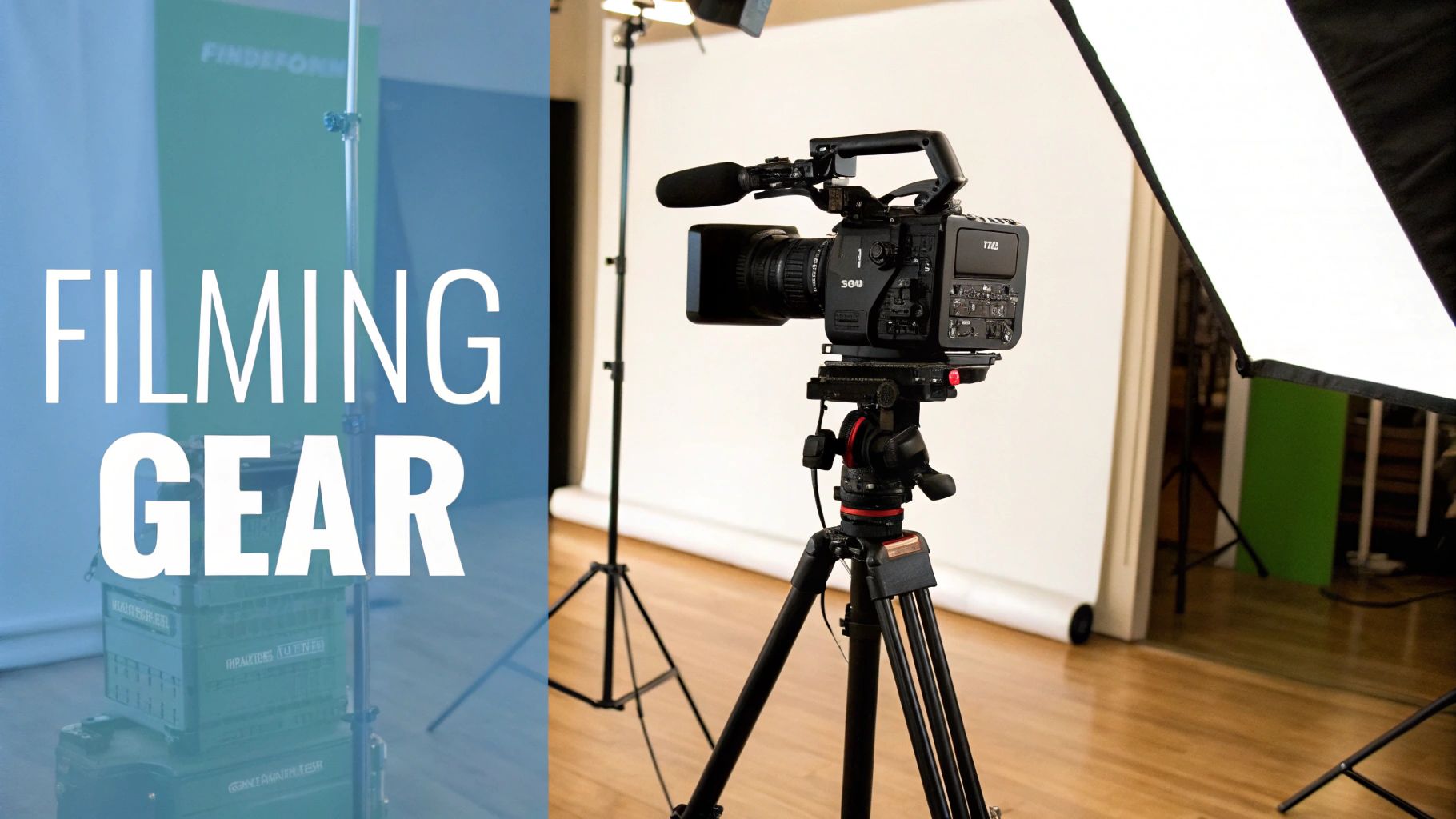
So you've created a brilliant product video. That's a huge win, but your job isn't done yet. A fantastic video sitting unseen in a forgotten folder won't sell a single thing. The next crucial step is getting it in front of the right eyeballs. This is where strategy comes in—turning your creative work into a powerful sales tool.
Thinking about distribution isn't just about blasting your video everywhere. It’s about thoughtfully placing the right video on the right platform to catch buyers at the perfect moment. A smart, multi-channel approach ensures your product videos for marketing get the maximum reach and deliver a real return on your investment.
On Your Website: The Conversion Home Base
Your website is ground zero for sales. It's the most critical place for your product videos because it’s where people make the final decision to buy. This is your home turf, where you control the entire experience.
The single most powerful spot is right on your product detail pages (PDPs). By placing a video next to your photo gallery, you let shoppers see the product in action right when they're most interested. It’s your chance to answer their lingering questions and show off the quality in a way that static images just can’t.
Think about it: when a customer is on your product page, they are actively looking for reasons to buy. A video showing the product's features or a close-up look can be the final nudge they need to confidently click "add to cart."
Don't stop there, though. Consider other high-impact areas on your site. A big, bold brand video on your homepage can instantly grab attention, while collection-specific videos on category pages can help guide shoppers and show them what’s new.
Social Media Feeds: Adapting for the Scroll
Social media is all about discovery. People are scrolling fast, and your video has to hook them in a matter of seconds. This means you can't just slap the same two-minute demo video on every platform and hope for the best. You need to adapt.
- Instagram & TikTok: These platforms are built for short, punchy, and usually vertical videos. Think quick-cut demos, user-generated-style clips, or behind-the-scenes content that feels natural in the feed. For these fast-paced apps, keep your videos under 60 seconds.
- Facebook & LinkedIn: You have a bit more breathing room here. These platforms can support slightly longer videos, especially if they tell a compelling story or offer real value. A well-placed customer testimonial or a short "how it works" video can perform great.
- YouTube: This is the world's second-biggest search engine, making it a powerhouse for shoppers doing their research. This is the ideal home for your longer, more detailed product demos, how-to guides, and in-depth tutorials. Make sure you optimize your titles, descriptions, and thumbnails with relevant keywords to get found.
Email and Beyond: Your Direct Line to Customers
Never underestimate the power of email. It's still one of the most effective ways to nurture leads and drive repeat sales. Just adding the word "video" to your email subject line can give your open rates a serious boost. Embedding a video thumbnail that links out to the full clip is a perfect way to re-engage a quiet list or announce a new product to loyal fans.
The impact of video on sales is undeniable. An incredible 87% of viewers say watching a product video has convinced them to make a purchase. And it makes sense, considering 78% of people would rather watch a short video to learn about a product than read about it.
Ultimately, a strong distribution plan is just as important as the video itself. By creating a strategy that spans your website, social media, and email marketing, you ensure your hard work pays off by connecting with buyers, building trust, and driving real growth for your brand.
Measuring What Matters for Video Marketing Success
Creating a great product video is a fantastic first step, but how do you actually know if it’s working? It’s easy to get caught up in view counts or the number of likes, but that’s like judging a car's performance by how shiny its paint is. It might look good on the surface, but it doesn't tell you if you're actually getting anywhere.
To truly understand your video's impact, you have to connect your efforts to real business results. The goal is to focus on metrics that reveal how your audience is behaving and how that behavior ultimately affects your bottom line. Are people watching all the way through? Are they clicking on your call-to-action? Answering these questions is how you start turning data into smart decisions.
Moving From Vanity Metrics to Actionable Insights
Vanity metrics can feel validating, but they don't tell the whole story. A video with 100,000 views that results in zero sales is far less valuable than one with 1,000 views that brings in 50 new customers. The trick is to shift your focus from feel-good numbers to data that signals genuine interest and purchase intent.
This is where engagement analytics come into play. By digging into how viewers are really interacting with your content, you can figure out what’s hitting the mark and what’s falling flat. This allows you to refine your strategy and get much better results over time.
Don't ask, "How many people watched my video?" Instead, ask, "What did people do after watching my video?" This simple shift in perspective is the foundation of a data-driven video marketing strategy that leads to real growth.
The KPIs That Truly Define Success
To measure what really matters, you need to track the right Key Performance Indicators (KPIs). These are the metrics that give you a clear, honest picture of your video’s performance and help you prove its return on investment (ROI).
- Viewer Retention Rate: This might be the most important engagement metric of them all. It shows you the exact percentage of your audience that is still watching at any given point in your video. If you see a massive drop-off at the 15-second mark, that’s a clear sign your hook isn't strong enough or the content isn’t delivering on its initial promise.
- Click-Through Rate (CTR): Your video’s call-to-action (CTA) is its most important job. The CTR tells you how many people actually clicked on your “Shop Now” button or “Learn More” link. A high CTR is a powerful signal that your video successfully motivated viewers to take the next step in their journey.
- Conversion Rate: This is the ultimate measure of success. It tracks how many viewers completed a specific, desired action after watching your video—things like making a purchase, signing up for a newsletter, or filling out a contact form. This is how you directly connect video views to revenue and prove its value.
For an even more detailed breakdown of these analytics, our guide on key video engagement metrics is a great resource.
Key Metrics for Measuring Video Marketing ROI
To help you get started, here's a quick look at the most important metrics and what they reveal about your campaign's performance.
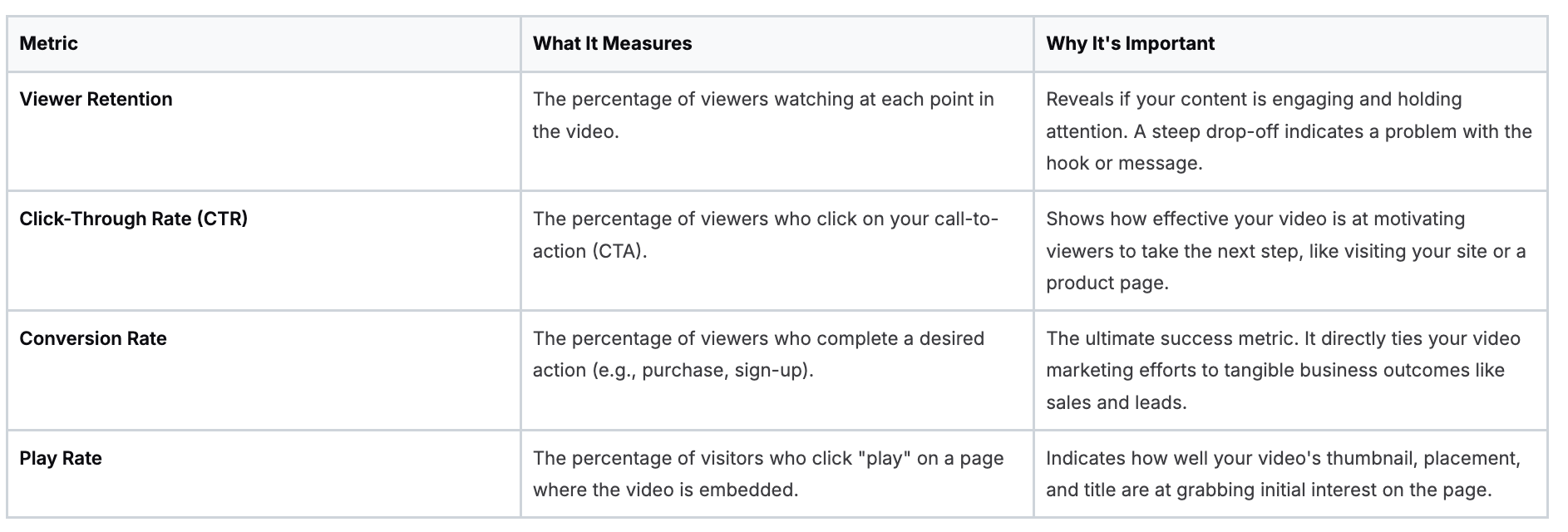
Focusing on these deeper metrics—retention, CTR, and conversions—is how you move beyond guesswork and start making truly informed decisions. This is how you optimize your product videos for marketing and create content that doesn’t just get seen—it gets results.
Frequently Asked Questions About Product Videos

Diving into product videos for marketing can feel like opening a can of worms. Suddenly, you're hit with questions about ideal video lengths, expensive-sounding gear, and a dozen other details. It's completely normal, and we've all been there.
This section is here to clear the air. We'll tackle the most common questions we hear, giving you straightforward, practical answers so you can stop wondering and start creating.
How Long Should a Product Video Be?
There's no magic number here. The right length for your video really depends on two things: where you're posting it and what you want it to accomplish.
Think of it like this: a quick chat with a friend is different from a deep, detailed conversation. For fast-scrolling platforms like TikTok or Instagram, you need to be brief and punchy to stop the scroll.
- Social Media Feeds (Instagram, TikTok, Facebook): Keep it short and sweet, aiming for 15-60 seconds. Your job is to grab attention in the first couple of seconds and deliver your message before they swipe away.
- Product Pages and YouTube: Here, you have a more captive audience. People are on these pages because they're already interested and looking for more information. A length of 1-3 minutes usually hits the sweet spot, giving you enough time to showcase features and benefits without losing their attention.
A good rule of thumb is to be as long as you need to be, but as short as you possibly can. Always respect your viewer's time. Check your analytics—if people consistently drop off at the 30-second mark, that's your cue to make your next video tighter.
What Is the Minimum Equipment I Need to Start?
This is a big one. So many people get paralyzed by the thought of needing a full-blown studio and a Hollywood budget. The truth is, you can start creating high-quality product videos for marketing with gear you probably already own.
The single most important tool is already in your pocket: your smartphone. Modern phone cameras are incredible and more than capable of shooting crisp, clear video.
Beyond your phone, there are two small investments that make a massive difference:
- Good Lighting: This is the secret sauce that makes products look professional and desirable. You don't need a complex setup. A simple ring light or a basic softbox kit will give you that soft, even light that erases harsh shadows and makes everything look better.
- Clear Audio: This is non-negotiable. Viewers will forgive slightly grainy video, but they will not tolerate bad audio. If they can't hear you clearly, they're gone. A simple, inexpensive lavalier (lapel) mic that clips onto your shirt will instantly make you sound a thousand times more professional.
You can get by with average video quality if your audio is perfect. But you can never get by with perfect video quality if your audio is terrible. Prioritize sound above all else.
With just a phone, a basic light, and a dedicated mic, you have a powerful setup. You can always upgrade later once you start seeing a return on your videos.
How Do I Make My Product Videos More Engaging?
Engagement isn't about fancy graphics or special effects. It's about connection. The most engaging videos tell a story that your customer can see themselves in, with your product positioned as the hero.
Instead of just listing features, show the benefits in action. Don't just tell people your blender has a powerful motor; show it obliterating ice for a smoothie in seconds. This "show, don't tell" approach makes the value real.
Here are a few more tips to boost engagement:
- Hook Them Immediately: You have about three seconds to earn their attention. Start with a question, a surprising visual, or a relatable problem that your product solves.
- Keep Up the Pace: Use quick cuts and different camera angles to keep things visually interesting. Long, static shots can feel stale and boring.
- Add Background Music: The right soundtrack sets the mood and adds a professional polish. Just make sure it matches your brand's vibe.
- Tell a Customer-Centric Story: Frame your video around a problem your ideal customer has. When they see their struggles on screen, they become emotionally invested in the solution you're offering.
And most importantly, every great video needs a strong ending. Give them a clear and compelling call-to-action (CTA). Tell them exactly what to do next, whether it’s "Shop the Collection" or "Learn More." For a deeper dive, check out our complete guide on product video marketing strategies.
Where Should I Place Product Videos on My Website?
Making a great video is only half the job. You have to put it where people will actually see it and where it can make the biggest impact.
The most valuable piece of real estate for a product video is right on the product detail page (PDP). This is where customers make the final decision to buy or leave. Placing a video next to your photo gallery lets them see the product in use at the exact moment their interest is at its peak. This builds huge confidence and has been proven to increase conversion rates.
But don't stop there. To get the most out of your product videos for marketing, consider these other strategic spots:
- Your Homepage: A high-energy brand video can make an incredible first impression and quickly show new visitors what you're all about.
- Category Pages: Use a video to introduce a specific collection or highlight a few best-sellers, guiding the customer's shopping journey.
- Blog Posts: Embed how-to videos and tutorials into relevant articles to add value and break down complex topics.
Placing videos on these pages doesn't just help customers; it's also great for SEO. Videos dramatically increase the time people spend on your site, signaling to search engines that your content is valuable and engaging.
Related content
Turn your videos into sales
Boost conversions by up to 30% by turning your existing TikToks and Reels into shoppable videos directly on your Shopify store.




.jpg)







